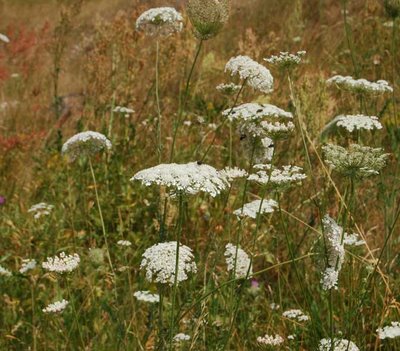
Wild carrot/ Vild gulerod
Daucus carota
Wild carrot grows in open fields and meadows, upon hills and in the edge of roads. The plant was cultivated as a food and cleansing plant back in the ancient Rome. The name carota comes from Greek karota, karoton and was used as a Latin name already in year 240. The Anglo Saxons used wild carrot in a drink, which was said to be able to keep away the Devil, a long time before the cultivated carrot came to England.
The carrot origins from southern Europe and was probably brought to the North by monks and cultivated in Denmark since the introduction of Christianity ab. 1000, it is not certain however if the wild carrot is original or feral in the Danish flora. The first certain information about cultivation of carrot is from the 1500s. People had the opinion that the kitchen herb carrot was brought to Denmark (Amager) with the Dutch whom Christian II fetched to the country in 1516.
In 1554 a load of carrots was sent from Copenhagen to Nyborg.(at Funen) In 1560 a load to Århus, in 1579 is mentioned two loads to Odense. In ab. 1650 it was commonly known that carrots were sown in the gardens and other fenced places. In East Jutland the carrot was used for fattening geese, but else it was not known as a fodder plant in Denmark still in the 1800s; the farmers said that "carrots are only eatable in summer". But later the carrot was recommended as a fodder plant instead of turnips, carrots made the cows fat quickly, their meat more tasty and the milk with no after-taste. In the late 1800s the carrot had about the same importance as turnips in fodder for cows, swine and especially horses, and special carrots were cultivated for fodder only. Wild carrot has sometimes been sown as a spice in grass fields.
The juice of the root was used to dye the light coloured winter butter, cheese was sometimes dyed too. It was als a common thing to cook the sugary juice for marmalade or syrup. Grated carrots mixed in rye flour gave a cheeper bread when the corn prizes were high. The dried root was grilled into a coffee substitute. Carrots were put in various soups - and today also used in all kinds of herbal soups, in chicken soup, in mixed stews etc.
In folk medicine the carrot plant was used to support the liver and the kidneys - and as a means for winds, stich in the side and as a love potion. It was said to help against obesity, poisoning, asthma , insomnia and colitis. Since the carotene in the plant helps the eye's retina to keep supple, it is used to cure night-blindness.
photo: grethe bachmann
1 comment:
World Carrot Museum! I cannot find any information about the colour of the roots in 1516, but here is the web-address of Amager Museum: (ref.Christian II - the Dutch)
http://www.museumamager.dk/index.php?option=com_content&view=article&id=36&Itemid=35
kind regards
grethe bachmann
Post a Comment